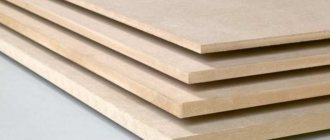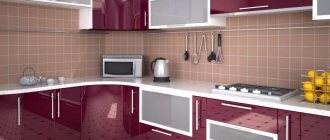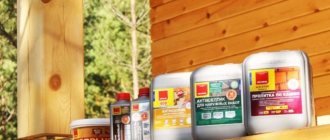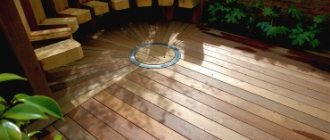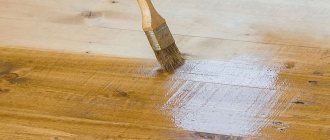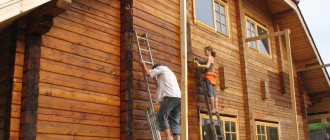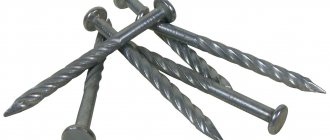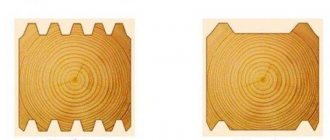In addition to traditional lumber made from natural wood, materials based on wood fibers and ordinary shavings have long been used for use in a variety of structures. In practice, the use of fiberboard and chipboard boards can significantly save forest resources, because they are made practically from industrial waste. But, despite the similarity and the same raw materials for manufacturing, these materials have different technical characteristics and purposes. That is why, in order to use them correctly, you need to know how fiberboard differs from chipboard.
Chipboard - characteristics and purpose
The production of chipboards or chipboards is based on pressing technology with sequential heating. The main raw materials for production are sawdust from coniferous and deciduous trees. After cleaning and grinding to the required fraction, the sawdust is mixed with an adhesive composition and, after forming a homogeneous mass, goes into a pressing-drying machine. This is where the formation of particle board occurs.
Under a hot press, a texture is formed in which the sawdust of the outer layers forms a monolithic dense layer, and the inner one has a looser consistency due to the unstructured arrangement of the sawdust. After drying at a temperature of about 190 degrees, the material is able to withstand heavy loads and is used as a basis for the manufacture of furniture, the construction of partitions and for the decorative design of premises.
The advantage of such a chipboard sheet is its density. The industry produces different sizes of slabs, the thickest having a thickness of 50 mm. Chipboards are easy to saw with a hand and electric saw. When processed, like natural wood, it can be sanded, milled, impregnated with impregnations, applied with a decorative coating and painted.
The smooth surface of the sheet allows you to make figures of different shapes from it; unlike wood, it does not have fibers oriented in a certain direction. But on the other hand, unlike wood, chipboard slabs are not able to withstand the load that boards of such thickness can withstand.
The range of particle boards includes boards for different purposes:
- Unpolished slabs;
- Sanded chipboard;
- Laminated chipboard;
- Chipboard is waterproof.
They vary in density and water resistance. During installation, fastening is carried out using the adhesive method, using self-tapping screws, screws, nails and furniture bolts.
The disadvantages of the material include poor water resistance, the impossibility of reusable use for installation in construction - holes for fastenings must be made in another place.
Manufacturing process
To create chipboard, coarse wood chips are used. Wood, chips and sawdust are used as a source of raw materials. The entire manufacturing process is carried out according to the following principle: first, the crushed raw material is dried, after which it is moistened with binder ingredients using a nozzle. Synthetic components act as binding elements. It is also useful to read about what laminated chipboard is and how it is made.
When using such ingredients in combination with paraffin-based emulsions, it is possible to obtain moisture-resistant laminated chipboard, on the cut of which specific inclusions of green conglomerates appear. Thanks to this unique production technology, the resulting product can be used for finishing and flooring in rooms where there is a high level of humidity. You can read about the sizes of chipboard sheets in our article.
In the video - making chipboard:
When processing a mixture such as chips and resin, the following material can form:
- single-layer – in this case, the chips of the poured fractions are mixed and evenly applied to the surfaces of the entire slab. In the photo - chipboard:
- two-layer - waste is used to make the underlying layer, and thin and wide shavings specially selected at the sputter are used for the front covering.
- two-layer, obtained on the basis of high-quality raw materials and core, for which lower-quality waste is used.
When the shaving carpet has been formed, it is sent for pressing, drying and cutting to the required size. If we consider what OSBI is, then the manufacturing process is also somewhat similar. Finally, the ends are polished. The grinding method is used as a finishing cladding. But this is done on the condition that the finished product will be sent for decorative cladding.
What is the technology for preparing plaster mortar?
Here you can see photos of kitchen aprons made of MDF.
What is cement made of? Check out the composition: .
Compared to chipboard decoding, fiberboards require two additional treatments after splitting the original raw materials into chips:
- Coarse grinding using defibrators.
- Fine crushing in refiners.
During this production, wood is split into individual fibers. After receiving the required mass, it is sent for subsequent processing in tanks in which the product is soaked in a water mixture. As a result, it is possible to give the slabs strength and water-repellent characteristics. After such preparation, the finished mixture is sent to casting equipment, where thermal pressing occurs at a temperature of 210-230°C and a maintained pressure of 3-5 MPa. Although many are more interested in MDF panels for wall decoration.
Finished fiberboard sheets can be subjected to additional thermochemical hardening treatment. As a result, it is possible to impart hardness to the sheets, which will allow them to be used for the manufacture of structural parts of buildings, arranging the subfloor, and making internal partitions.
Fiberboard
Fiberboards are similar in manufacturing technology to chipboards. The only difference in this technology is the raw materials. If crushed shavings or sawdust are used for chipboard, then wood flour or wood dust is used for fiberboard. The binding components also differ; in the first case these are not mineral adhesives, in the second they use synthetic fibers and polymer additives.
The rest of the technology is similar, pressing at high temperatures. The prepared mass is rolled out to the required thickness, after which it enters the drying press. As a result, after drying, a canvas with a thickness of 2 to 10 mm is obtained.
Fiberboard is dense, which is why it is often used for packaging equipment and machinery. Along with its density, it bends easily and takes the desired shape. It is even easier to attach it to structures - it is easily fastened with nails, self-tapping screws and, importantly, construction staples.
Wood fiber sheets are used in construction, design, and even art. Just like chipboard, there are several types of fiberboard - plain, laminated, painted and sanded.
Safety
Unfortunately, both materials can be toxic. In the manufacture of chipboards, phenol-formaldehyde resins are used, which are hazardous to human health. Fortunately, many modern manufacturers are trying to solve this problem by using urea when creating slabs. Manufacturers coat slabs with these compounds, which makes them less toxic.
The situation is worse with fiberboard. Often their toxicity exceeds permissible limits. Therefore, when purchasing fiberboard, you should ask the seller about the availability of a hygienic certificate of conformity. The E1 designation on the fiberboard packaging indicates that the product is quite clean from an environmental point of view. You can take a similar product.
What are the similarities and differences between chipboard and fibreboard?
When comparing chipboard and fiberboard, it is necessary to understand the purpose and conditions of use of the material. With the same thickness and size of materials, the difference will be observed primarily in mechanical strength. Particle boards can withstand greater loads than fibreboards. The difference when examining the cut is immediately noticeable - in the first one you can see chips of different sizes, and in the second one, it has a homogeneous mass. The sheets will look different even after exposure to moisture - wood chips will swell even after being in water for a short time. For wood fiber sheets, short-term exposure to water is not dangerous.
With the same thickness, the thermal insulation properties of fiberboard are higher, but when loaded, the advantage is on the side of chipboard. The differences also lie in the quality in which one or another material will be used. Chipboard panels have found application in construction and the production of cabinet furniture. Fiberboard is mainly used as raw material for packaging and decoration. The only place where you can’t do without it is in the manufacture of cabinet furniture - all the back walls of cabinets and chests of drawers, as well as the bottoms of drawers, are made of high-quality fiberboard.
Conclusions TheDifference.ru
- Chipboard is made from shavings and other waste of low-value wood with the addition of synthetic resins, and fiberboard is made from wood dust and cellulose fibers with the addition of synthetic polymers, rosin and paraffin.
- The thickness of fibreboards ranges from 2.5 to 12 mm, and the thickness of particle boards can reach 25 mm.
- Fiberboard has higher moisture resistance, and chipboard can withstand heavy loads.
- The cost of fiberboard is significantly lower than chipboard.
- Chipboard is used for the manufacture of furniture structures, when laying floors, and fiberboard is used in the production of drawers, back walls of furniture, shelves, racks, and the construction of partitions.
- The service life of fiberboard is longer than chipboard.
Which material is better to choose
The use of this or that material depends on the conditions where it will be used and the tasks that are assigned to it. To insulate the floor, you can use both materials as a substrate for the final coating. But at the same time, if the floor has uneven surfaces, preference is given to chipboard panels, and if the finishing screed is made with high quality, an ordinary fiberboard sheet with a thickness of 4-5 mm is sufficient.
In the manufacture of cabinet furniture, chipboard is used for the walls and facade; it is entrusted to become load-bearing walls. But for fiberboard there is only application in the form of a back wall. On the other hand, it is more often used for the design and manufacture of upholstered furniture - sofas, trestle beds, couches. Due to the fact that fiberboard can be bent, backs and sides are obtained from it.
These materials also find their use in construction. Both chipboard and fibreboard are used for internal partitions, however, given their characteristics, they are not suitable for rooms with high humidity. On the other hand, a partition made from chipboard is not only stronger, but also cheaper - the frame for it will cost less than for fiberboard.
Knowing all these features, it is not difficult to determine the possibilities of using materials in practice. But be that as it may, working with them does not require great skills and abilities.
Options for using slabs and their disadvantages
During construction and repair work, chipboard is used for dry screeding and flooring installation. Also, such slabs are needed as a sheathing structure, which serves as reinforcement for foundations located vertically. They are also used to build canopies, partitions, fences and various pieces of furniture, including tables and beds.
The negative aspects of this material include its hygroscopicity, slight looseness and rigidity, which leads to the appearance of cracks if the slab is attached to an uneven surface. Therefore, it is necessary to take these properties into account in the process of developing a suitable design project.
Also, exposure to high humidity conditions has a negative effect on chipboard. This leads to deformation and a reduction in service life. It’s also worth considering if you want to reuse slabs to create prefabricated products. The fact is that when the fasteners are reinstalled, the material in this place begins to become covered with a network of cracks and crumble, and as a result, screws and self-tapping screws will not be able to securely fix the slabs.
Chipboards are divided into categories depending on:
- water resistance, which can be medium or high;
- density - minimal, medium or high;
- surface - it can be sanded, not sanded, or covered with a layer of laminate.
Boards that are impervious to moisture are often used for the base of kitchen countertops, pieces of cabinet furniture intended for the bathroom, as well as for various construction purposes. Laminated chipboards are distinguished by a wide choice of shades and textures; in addition, this material can withstand thermal effects and mechanical shocks.
Kitchen furniture: chipboard or MDF?
The kitchen set plays an important role. It should be practical, inexpensive and beautiful. Today, headsets made from different materials are sold: chipboard, plastic, wood and MDF. But kitchen countertops made of MDF and chipboard are popular. These two materials are similar in appearance and manufacturing method. But what is better for the kitchen: MDF or chipboard? Let's try to figure it out.
According to professionals, it is better to give preference to the fine dispersion fraction. This material is not so toxic, is stronger and looks much more attractive. But on this last point there is disagreement among people. Some believe that furniture made from laminated chipboard looks much more elegant than furniture made from finely dispersed fraction. What material to choose kitchen furniture from is up to the owner of the apartment to decide. But, undoubtedly, before choosing, you should know all the disadvantages and advantages of both materials.
What a buyer of custom-made kitchen furniture needs to know about materials
- A – acrylic. Acrylic is called MDF boards, coated on the front side with acrylic varnish in 12 layers above the pattern. It is no coincidence that MDF-based acrylic varnish panels are called high-gloss panels: they glow much more than any other panel. Acrylic used in the manufacture of kitchen facades meets all environmental safety requirements. Most other acrylic materials are resistant to various damages: scratches, chips, deformations. The color is very rich, with a competent approach to design you can create a truly unique interior of its kind. The kitchen will not lose its attractiveness even after many years - the color does not disappear or fade.
- D – fiberboard. DVP – This is familiar to all of us. The backs of most cabinets, the bottoms of drawers, those sheets that feel rough to the touch are fiberboard. (Most expensive furniture uses plywood instead of fibreboard, but it's not much better in terms of performance). Like MDF, fiberboard is made from compressed wood dust, but in the case of fiberboard parts, the wood is steamed and the board is produced by wet pressing. That is why the “back side” of the fiberboard texture resembles the surface of cottage cheese with a “mesh”, like wet gauze.
- K – Corps. The body is, in fact, two side walls, as well as the top, bottom and back walls of your furniture. Shelves and drawers (filling) are also included in the concept of the Body.
- K – Credit for materials. A loan for custom-made kitchen materials is provided not by the manufacturing company, since by law it does not have the right to carry out such transactions with money, but by a bank or other similar enterprise. When using a loan, the bank usually takes a certain percentage of the loaned amount as its own earnings.
- K - ABC edge. Impact-resistant and with excellent consumer qualities, this edge has proven itself in furniture production. Unlike the well-known melamine edge, it is stronger and therefore a more durable product. If the melamine edge is no more than 10 years, then for the ABC edge, fifty years is not a period. It is more likely that the chipboard will disappear or the glue will dry out than the edge itself will lose its original appearance.
- K – melamine chrome. Paper-based edgebanding tape is an excellent material for processing the ends of furniture panels. It is produced by impregnating decorative paper with melamine resins, increasing their wear resistance and treating the surface with varnish to prevent evaporation of the resins. The material is a film with a thickness of 0.3-0.4 mm.
- L – LDPE. Chipboard is a laminated chipboard made from sawdust and chips impregnated with a binder, namely formaldehyde resins. Chipboard is used to make furniture cabinets and is often used for fronts. Chipboard is an excellent material for making furniture; it is quite durable and has a very large color palette.
- M – MDF. MDF is a sheet made from very small wood chips. The difference between chips for chipboard and MDF is both between the products that pass through the meat grinder and the products crushed by the mixer. The wood particles are attached with lignin and paraffin under high pressure. MDF is considered a more environmentally friendly material than chipboard.
- P – film. The phrase film facades is commonly found. Such facades are made on the basis of MDF boards, onto which figure milling is applied. On top they are covered with PVC film with a thickness of 0.3-0.5 mm. The variety of PVC films in color and texture is very high, and they have different degrees of gloss.
- R – Installment plan for materials. Installment payment for materials is provided by the manufacturing company when selling goods to the buyer, if this is stipulated by the contract. Installment plans are usually interest-free.
- C – Discounts. Discounts are provided by the manufacturing company for its customers. Discounts can be temporary (Promotion) or permanent. Real discounts cannot be 20%, 30%, even a 10% discount is extremely rare, because... this significantly reduces the manufacturer's income. Discounts of 20-30% are a common trick, or deception of the buyer, in which the price of the product rises very high, then from this inflated price a discount is made to the regular selling price. The buyer does not receive a real discount.
- F – Facades. Facades are the doors of your cabinets and other furniture, as well as non-opening surfaces located on the front side of the furniture.
- F – Accessories. Accessories are various handles, legs, hooks, baskets and other metal or not very metal (for example, plastic)
MDF for flooring: pros and cons
Stage 2. Base for laying fiberboard
The base can be a wooden floor. When laying fiberboard on a wooden floor, slabs with a thickness of about 6 mm are used.
A perfectly flat surface is also obtained by using a sand-cement screed, which is made in accordance with the drawn line. Before starting work, sand no more than 50 mm thick is poured onto the coating, which must first be cleaned and well dried, and the finished solution is distributed on top of it.
Which is better: heated floors or radiators?
Warm floorBatteries
The photo shows a self-leveling screed poured in a thin layer onto a concrete base
Then a primer or bitumen dissolved in gasoline is applied to the screed. In this case, it is important to wait about 8 hours for them to dry until they begin to “come off.” Only after this can you lay fiberboard sheets on it using mastic or glue.
The screed is covered with a thin layer of glue or mastic over the entire surface.
Laying chipboard on joists. Fiberboard sheets will be laid on top, which will become the finishing floor covering.
To keep the logs at the same level, chipboard linings are used. Those that are already on the floor are carefully inspected and repair work is carried out if necessary. Before laying a fiberboard floor, carefully measure the room. It must be taken into account that the width of the slabs should not exceed the width of the joists, otherwise the floor will become uneven and the furniture will fall over.
Ease of processing
The advantages of MDF also include its high manufacturability. This indicator determines the ease of processing of the material. The panels can be quickly produced into various profiles, multiple moldings and rounded corners. This significantly expands the scope of application of the slabs even at the stage of product design or when developing the future design of the room.
MDF boards can be laid on the floor, since their characteristics are identical to natural wood, but the advantage of this material is that it costs less. As a laying material for floors or wall panels, wood board material is also selected based on a number of other indicators:
You can also lay a floor with MDF without the risk of fungi and various pathogens - the material is highly hygienic and therefore safe for use for domestic purposes.
Having not found a single disadvantage in using MDF as a finishing material, we can summarize - these are panels of a high degree of reliability, with a wide range of applications and a low price, which are not inferior in their capabilities to natural wood.
This website is for informational purposes only and under no circumstances do the information materials and prices posted on the site constitute a public offer as defined by the provisions of Article 437 of the Civil Code of the Russian Federation
High-quality finishing work largely depends on the correctly selected material. Thanks to modern technologies, the construction market is saturated with various options. But for rough or finishing floor coverings, the most popular are OSB, plywood, chipboard, fiberboard and MDF. This variety allows you to select a product to perform specific tasks.
Chipboard, laminated chipboard, fibreboard, MDF and hardboard: what are they, the differences
Due to its many advantages, MDF is often used in the construction industry, for the production of furniture and as a finishing material for renovation work, including flooring.
Expert opinion
Strebizh Viktor Fedorovich, leading construction foreman
In the production of furniture, we mainly use solid wood, fibreboards and chipboards. If you want to clarify something, please contact me!

